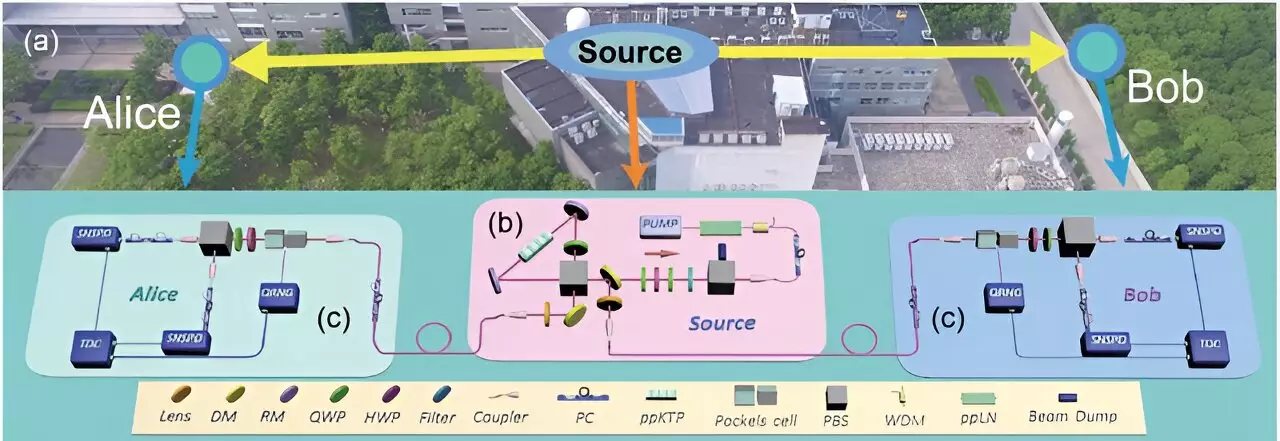The field of quantum mechanics often challenges our conventional understanding of reality, and at the forefront of this debate is Hardy’s paradox. Introduced in the 1990s by physicist Lucien Hardy, this paradox serves as a critical experiment for testing the principles of local realism—the idea that physical properties exist independently of observation and that information cannot travel faster than light. Recent research carried out by a team from the University of Science and Technology of China (USTC), in collaboration with Nankai University, presents a significant advancement in confirming Hardy’s paradox through a novel experiment that eliminates both the detection efficiency and locality loopholes—two persistent obstacles that have hindered previous efforts.
Local realism asserts that the outcomes of measurements should not be influenced by factors outside the local environment—including the influence of distant events. To experimentally verify Hardy’s paradox, researchers must ensure that both loopholes are closed to provide a credible validation of quantum mechanics. The locality loophole arises when measurement choices at one location can affect outcomes in another, potentially skewing results. Simultaneously, the detection efficiency loophole results from losses in optical systems that can lead to misleading interpretations of entangled particles. Successfully addressing these challenges is essential for providing robust evidence against local realism and solidifying the foundations of quantum theory.
The research team, led by notable physicists including Prof. Pan Jianwei and his collaborators Zhang Qiang and Chen Kai, designed an intricate experiment that meticulously sidestepped both loopholes. They created a spacetime experimental setup ensuring measurements were spacelike separated from both the entangled state preparations and photon detections. This innovative configuration guarantees that any potential influence from measurement settings on outcomes is eliminated.
To combat the detection efficiency loophole, the experiment boasted an impressive detection efficiency of 82.2%. This high level of efficiency significantly dampens the effects of optical losses, enabling the researchers to distinguish between valid entangled events and background noise. To add further reliability to their findings, they employed high-speed quantum random number generators in selecting measurement settings. This crucial step provided a much-needed layer of true randomness, safeguarding against any unintended manipulation from local hidden variables.
Over a rigorous six-hour experimental window, the team ran 4.32 billion trials, ultimately revealing a strong violation of Hardy’s paradox. They achieved a significance level of up to 5 standard deviations, presenting a clear contradiction to local realism. The null hypothesis test applied indicated that the likelihood of reconciling their results with local realism was astonishingly low—less than the probability of 10^-16348, delivering a resounding confirmation of quantum nonlocality.
By refining their approach through a nuanced interpretation of Hardy’s inequality, the researchers additionally accounted for undetected and double-click events, further closing the detection efficiency loophole.
This milestone not only contributes to the foundational understanding of quantum mechanics but also has far-reaching implications for the development of advanced quantum technologies. The experiment serves as a powerful testimonial to the principles underlying phenomena such as quantum key distribution and quantum random number generation. With clear evidence reinforcing quantum nonlocality, researchers can explore new avenues for enhancing the security and efficiency of quantum information systems, marking an important step towards practical applications that harness quantum mechanics.
As scientific inquiry delves deeper into the intricacies of the quantum realm, the research conducted by USTC and Nankai University illustrates the potential of addressing longstanding questions in physics. The success of this experiment not only affirms Hardy’s paradox but also strengthens the philosophical discourse surrounding the fundamental nature of reality itself, raising new inquiries into the interplay between observation and physical existence.
In concluding, the exploration of Hardy’s paradox through this innovative experimental framework solidifies our understanding of quantum mechanics. By decisively closing critical loopholes that have challenged the validation of quantum theories, this research sets the stage for profound advancements in both theoretical physics and practical quantum technologies. As we continue to confront the enigma of quantum mechanics, studies of this caliber illuminate pathways toward a more comprehensive grasp of our universe.

